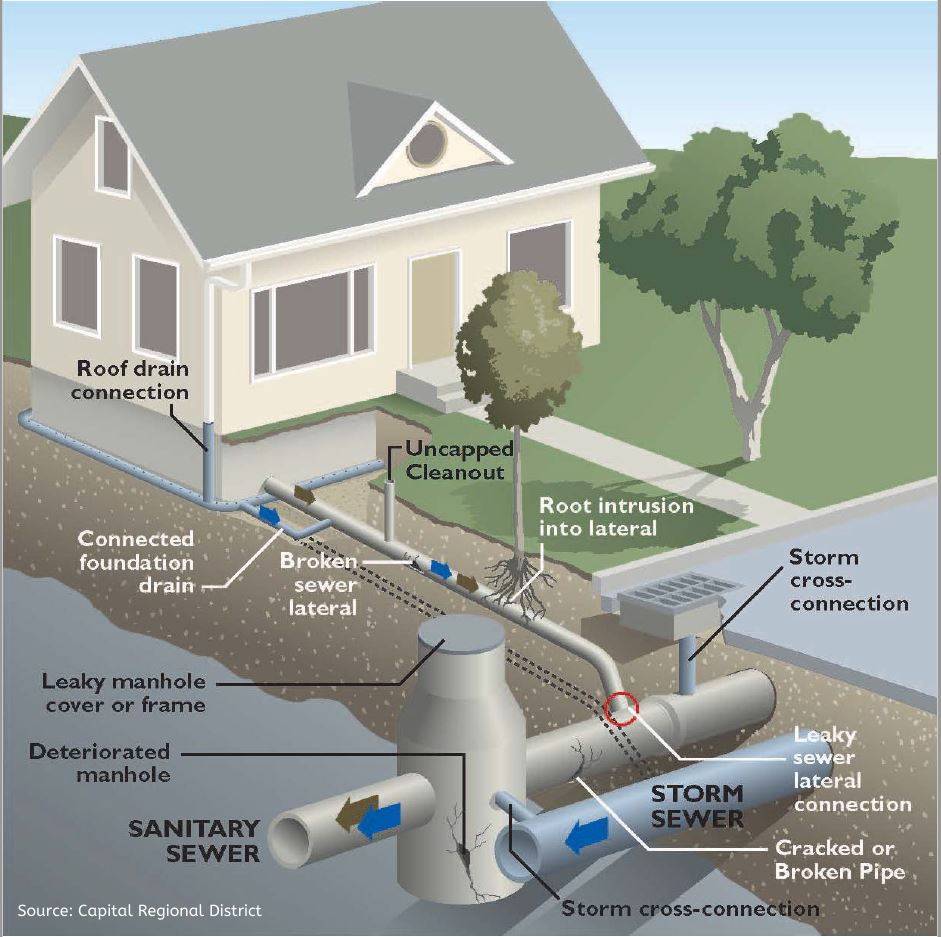Inflow And Infiltration

Inflow and infiltration (I&I) happen when water from the environment that does not need to be treated enters the sewage system. Infiltration refers to groundwater entering the system. Inflow refers to rainwater (stormwater) entering the system.
The RDN and member municipalities have a separated sewer made up of two sewer systems:
- Sanitary sewer: designed to carry sewage to facilities that treat the water before returning it to the environment.
- Storm sewer: prevents streets from flooding by draining and carrying excess stormwater (from rainfall and snowmelt) to a stream, lake or the ocean.
Understanding I&I YouTube Videos (from the Capital Regional District)
- Part 1: Introduction
- Part 2: The Impact of Rainwater Entering the Sanitary Sewer System
- Part 3: How Property Owners Prevent Rainwater from Entering the Sanitary Sewer System
- Part 4: How Municipalities Prevent Rainwater from Entering the Sanitary Sewer System
What are sources of I&I?
Examples of sources of I & I include:
- Stormwater cross connections
- Roof rain lead connections
- Leaky pipe joints and structural defects
- Leaky manhole covers.
Why is I&I a problem?
Inflow and infiltration are problems because they:
- Reduce the capacity of the sewage system leaving less for existing residents and future growth
- Make sewage treatment less efficient since the sewage is diluted by water
- Increase the cost of water to residents because sewage treatment plants are required to treat a higher flow volume
- Increase risk of sewage overflows or overwhelm treatment plants leading to health risks and environmental or property damage.
While rare, sanitary sewer overflows have occurred from the RDN system during extreme rainfall events. The risk of future overflows is lowered as I&I are reduced.
How can we fix I&I?
To date, the RDN and member municipalities have focused efforts on strategically addressing I&I in owned infrastructure. However, I&I can be difficult to manage since 70% can originate on private property. Homeowners can help reduce I&I too:
- Know where your sewer lateral is on your property
- Avoid planting trees and shrubs over sewer laterals as roots seek water and can damage sewer pipes
- Check your gutters and drains to ensure they are not connected to the sanitary sewer system.
- Disconnect roof downspouts from the sanitary sewer system. Even better, install a rain barrel under your roof leader, if conditions permit
- Disconnect foundation drains and groundwater sump pumps from the sanitary sewer system
- Have your property's sewer lateral inspected. Replace any known broken, leaky or problem sections of your property's sewer lateral. Maintaining and repairing the lateral is the homeowner's responsibility and can reduce I&I and prevent sewer backups into your home.